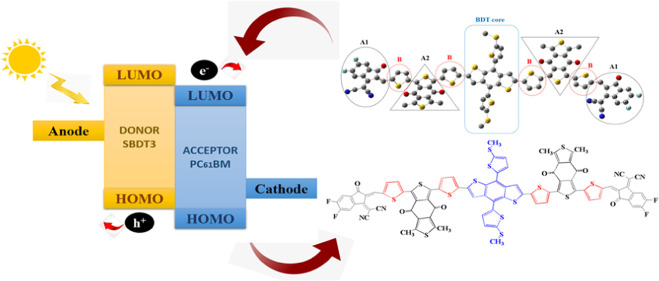- Record: found
- Abstract: found
- Article: found
Tuning of a A–A–D–A–A-Type Small Molecule with Benzodithiophene as a Central Core with Efficient Photovoltaic Properties for Organic Solar Cells

Read this article at
Abstract

With the aim of upgrading the power conversion efficiency of organic solar cells (OSCs), four novel non-fullerene, A 1–A 2–D–A 2–A 1-type small molecules were designed that are derivatives of a recently synthesized molecule SBDT-BDD reported for its efficient properties in all-small-molecule OSCs (ASM-OSCs). Optoelectronic properties of the designed molecules were theoretically computed with a selected CAM-B3LYP functional accompanied by the 6-31G(d,p) basis set of density functional theory (DFT), and excited-state calculations were performed through the time-dependent self-consistent field. The parameters of all analyzed molecules describing the charge distribution (frontier molecular orbitals, density of states, molecular electrostatic potential), absorption properties (UV–vis absorption spectra), exciton dynamics (transition density matrix), electron–hole mobilities (reorganization energies), and exciton binding energies were computed and compared. All the designed molecules were found to be superior regarding the aforesaid properties to the reference molecule. Among all molecules, SBDT1 has the smallest band gap (3.88 eV) and the highest absorption maxima with broad absorption in the visible region. SBDT3 has the lowest binding energy (1.51 eV in chloroform solvent) ensuring easier and faster dissociation of excitons to produce free charge-carriers and has the highest open-circuit voltage (2.46 eV) with PC 61BM as the acceptor. SBDT1 possesses the highest hole mobility because it has the lowest value of λ + (0.0148 eV), and SBDT4 exhibits the highest electron mobility because it has the lowest value of λ – (0.0146 eV). All the designed molecules are good candidates for ASM-OSCs owing to their superior and optimized properties.
Related collections
Most cited references50
- Record: found
- Abstract: found
- Article: not found
Long-range corrected hybrid density functionals with damped atom-atom dispersion corrections.
- Record: found
- Abstract: found
- Article: not found
An electron acceptor challenging fullerenes for efficient polymer solar cells.
- Record: found
- Abstract: not found
- Article: not found